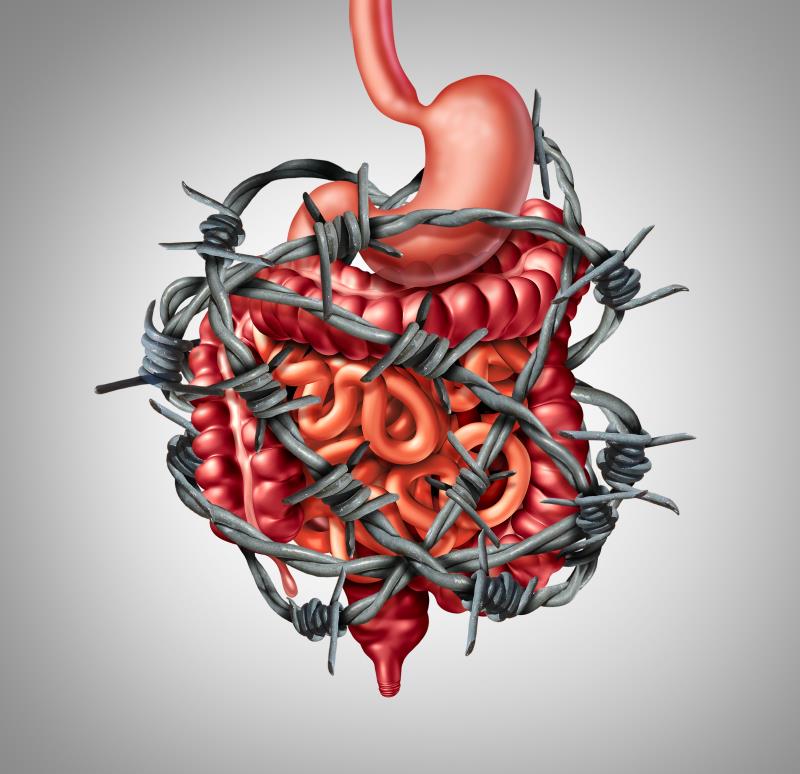Gentle zap of electricity to ear relieves stomach pain in teens with IBS





Delivering percutaneous electrical nerve field stimulation (PENFS) to the external ear via a noninvasive device helps ease abdominal pain and improve overall wellbeing in teens with irritable bowel syndrome (IBS), as shown in a study.
“This is the first prospective study evaluating the effectiveness of auricular neurostimulation for IBS,” the investigators said.
“This therapy could possibly be used to provide symptom control to avoid or shorten hospitalizations, reduce the need for emergency room visits, and improve wellbeing in conjunction with other IBS management strategies,” they added. “For patients with more severe pain, PENFS could be used to facilitate patient engagement in cognitive behavioural therapy or biofeedback and expedite long-term improvement.”
In the study, 27 teenagers (median age, 15.3 years; 24 girls) were randomized to receive PENFS and 23 to a sham stimulation (median age, 15.6 years; 21 girls). Treatment sessions were conducted 5 days weekly for 4 weeks.
After 3 weeks of treatment, 59 percent of patients who received PENFS achieved the primary endpoint of ≥30-percent reductions in worst abdominal pain as opposed to only 26 percent of those who received the sham stimulation (p=0.024). [Clin Gastroenterol Hepatol 2020;18:1987-1994.E2]
Accordingly, the PENFS group had significantly lower composite pain (median 7.5, interquartile range [IQR], 3.6–14.4 vs 14.4, IQR, 4.5–39.2; p=.026) and usual pain scores (median, 3.0, IQR, 3.0–5.0 vs 5.0, IQR, 3.0–7.0; p=0.029) compared with the sham group.
“Reducing abdominal pain severity, regardless of baseline pain level and despite incomplete symptom control, has a crucial role in the general wellbeing of IBS patients,” according to the investigators.
Indeed, pain relief came with an improvement in overall wellbeing based on a global symptom response scale score of ≥2 at 3 weeks. This was observed in 82 percent of patients in the PENFS group vs 26 percent of those in the sham group (p≤0.001). No significant side effects were reported.
“The results are clinically relevant given the poor efficacy of pharmacological therapies for children with functional abdominal pain disorders and the critical need for alternative, safer treatment options.” [J Pediatr 2015;166:424-431]
The number needed to treat (NNT) to reach the primary endpoint of 30-percent improvement in worst abdominal pain was only three. In comparison, currently approved medications for the treatment of IBS such as lubiprostone, linaclotide, and rifaximin have NNT varying between six and 14. [World J Gastroenterol 2014;20:8796-8806]
First medical device for IBS pain
Recently approved by the US Food and Drug Administration (FDA) for abdominal pain in children with IBS aged 11–18 years, the device that delivers PENFS, namely IB-Stim, consists of a small disposable electrical nerve stimulator placed behind the ear. It emits low-frequency electrical pulses to stimulate branches of certain cranial nerves continuously for 5 days, at which time it is replaced. [https://bit.ly/2G6VoqF]
Stimulating nerve branches in and around the ear is thought to work by modulating central pain pathways and attenuating visceral hypersensitivity. The device can be used for up to 3 consecutive weeks to reduce functional abdominal pain associated with IBS. [Neuroscience 2017;356:11-21]
“Currently, there are no other FDA-approved therapies for IBS that target pain at the central nervous system level. Most approved medications target the bowel to improve stool frequency,” the investigators said. They argued that IBS-Stim should also be considered for adults on the basis of its safety profile and the likely mechanisms.
“Future studies should focus on characterizing short and long-term responses to PENFS in different IBS subtypes and other functional GI disorders, finding the optimal duration of therapy while also assessing changes in stool pattern,” they added.